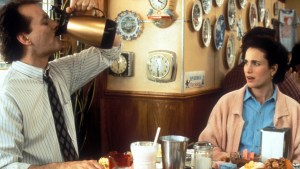Nothing gets me out of the February winter doldrums faster than my annual viewing of director Harold Ramis’s 1993 film Groundhog Day. Celebrating its 30th anniversary this year, the film is a quintessential 1990s romantic comedy with a high concept premise and winning performances from a sardonic Bill Murray, an angelic Andie MacDowell, and a talented ensemble of familiar-faced character actors.
But it’s so much more than that, too.
Groundhog Day is a surprisingly deep, sometimes dark, and altogether moving examination of the human condition and the spiritual life: our search for happiness, our proclivity to sin, and the need for a deeper purpose to our lives.
Enter Phil Conners, an egomaniacal jerk in the bloodline of several such characters that Bill Murray perfected throughout this era of his career. As a local TV weatherman, Phil is arrogant, bitter, hedonistic, and lonely. He detests his annual assignment to head to sleepy Punxsutawney, Pennsylvania, for the annual Groundhog Day festivities. This year he is accompanied by his hapless cameraman Larry (Chris Elliott) and his spunky, attractive new producer Rita (Andie MacDowell).
We join this trio on their first foray through the day and then realize along with Phil that the day is happening all over again … and again … and again.
What follows is a comedic but compelling glimpse into the various stages of Phil’s response to his new repetitive life. After his initial confusion subsides, Phil is struck by the seeming freedom of life without rules. He uses his newfound “power” to eat whatever he wants, rob a bank, take advantage of women, and satisfy any other selfish urges that occur to him. Attracted to Rita but obviously out of her league, he spends numerous days learning all about her in the hopes of appearing to be her perfect match and taking her on the perfect date, so he can manipulatively satisfy his carnal urges.
Of course, it never works out for him, but as the repetitive days turn into repetitive months (a film blogger with better math skills than me estimated that Phil spent almost 34 years reliving Groundhog Day according to data presented in the film), he realizes that the freedom to do whatever you want is no freedom at all.
As Pope John Paul II once said, “Freedom consists not in doing what we like, but in having the right to do what we ought.” Having done everything that he liked and still not found any semblance of happiness or fulfillment, Phil becomes despondent and suicidal.
Phil’s redemptive arc stems from his dissatisfaction with selfish alternatives and is not overtly religious, but once again spiritual comparisons abound. Phil’s awakening begins with a new appreciation for beauty. After another failed date with Rita, he remarks to himself that she is one of the kindest, most genuine people he has ever met, and that she deserves to be with someone who will cherish and honor her. He starts taking piano lessons, learns to speak French, and is later shown carving beautiful ice sculptures as the townspeople watch in awe.
But his personal development is just the beginning. Phil starts to recognize the inherent goodness and dignity of the Punxsutawney community he had previously derided. He uses his endless time to invest in their lives and devotes his daily schedule to acts of chivalry, heroism, and kindness—to the point where he becomes a pillar of the community in a mere 24 hours.
By choosing to live his life for others and turn away from sin, Phil achieves true happiness despite his circumstances, authentically wins the affection of Rita, and ultimately breaks the spell.
While others have written about Punxsutawney as Phil’s personal purgatory, I think it can also be emblematic of our time on Earth and the endless struggle for self-improvement on the road to holiness. How often are we stuck in our own Groundhog Day-like cycle of sin? Guided by our addictions, wounds, and ambitions, we can stagger through life accepting selfish mediocrity when God is calling us to something much greater—and giving us the free will to choose that for ourselves.
C.S. Lewis wrote, “We are half-hearted creatures, fooling about with drink and sex and ambition when infinite joy is offered us, like an ignorant child who wants to go on making mud pies in a slum because he cannot imagine what is meant by the offer of a holiday at the sea.”
Much like Phil at the beginning of the film, we are adept at making mud pies. We need signs of truth, beauty, and goodness to remind us of God’s grace at work in our lives. Best of all, we are blessed with daily opportunities to choose to act as we ought—clinging to the joy of the resurrection to ward off the fierce temptation and bitter sting of sin.
We are called to will the good of those around us, living our lives as signs of God’s love in the world. This means denying the fleeting pleasure of greedy impulses and the false comfort of self-preservation. We must risk everything in the pursuit of holiness. This is the only path out of the monotony of sin and will lead us in glory to “the end of a very long day.”



